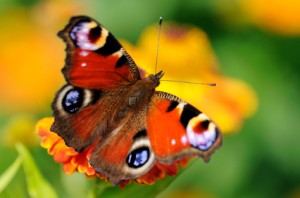Top 10 ways to attract wildlife to your garden
 Creating a thriving garden is about more than simply planting flowers and mowing the lawn. Your garden is an ecosystem that relies on a number of species, both flora and fauna, to help it grow. Below we have listed our top 10 ways to attract wildlife into your garden and how to keep them coming back again.
Creating a thriving garden is about more than simply planting flowers and mowing the lawn. Your garden is an ecosystem that relies on a number of species, both flora and fauna, to help it grow. Below we have listed our top 10 ways to attract wildlife into your garden and how to keep them coming back again.
Flowers
This may seem like a given but having a variety of flowers in your garden can do wonders for attracting wildlife. Bees, birds and butterflies all rely on flowers for pollination and food so get creative and see how many different species you can grow. And remember – the more colourful and fragrant, the better!
Toads and frogs
These little amphibians live on insects and can eat thousands in their lifetime. Encouraging frogs and toads to your garden will help keep insect numbers down, particular slugs and snails which are the bane of many a vegetable grower. The easiest way to get more froggy friends is to create a pond. Remember to give it cover from birds and don’t let newts take up residence – they will eat young frogs and tadpoles.
Hedgehogs
The number of hedgehogs seen in British gardens has declined over the years, which is quite a shame considering how much good they can do. Like frogs and toads, hedgehogs are voracious eaters of insects and pests and will help keep your vegetables nibble-free. Creating a log pile in a corner of your garden will encourage these spiky critters to set up home and if you want to feed them, serve them dog or cat food – not bread and milk.
Ponds
As well as making a great home for frogs and toads, ponds can attract a wide variety of wildlife to your garden. Dragonflies, damselflies, birds and many other winged creatures rely on ponds to survive and there is an assortment of plant life that can be grown in and around your pond. Just remember to put some form of protection in if you have hedgehogs or small children running around.
Hedges and shrubs
Hedgerows and shrubberies are natural barriers that have been used to divide up land for centuries. There are also havens for a wide selection of flora and fauna; from birds and mice to bugs and butterflies, offering food, shelter from the elements and protection from predators.
Bird feeders and boxes
A simple birdfeeder can make a great difference to your garden by attracting many species of bird. From tiny wrens and robins to wood pigeons and finches, bird feeders are an easy way to start getting some life back into your garden. You may even get a squirrel or two if you add a few nuts to your bird table.
Badgers and foxes
Nature is a balance and it is not always pretty. Encouraging frogs and toads into your garden will help keep slug levels down, but it might also attract some larger members of the natural world. Badgers and foxes will eat a number of the creatures living in your garden, so if you want to see them in your garden, be prepared for what they might decide to have for dinner.
Compost heap
As well as providing compost for your garden and allotment, a compost heap is also home to a variety of creatures. The warm, humid conditions are perfect for a number of insect species and earthworms will love the shelter and protection from birds.
Bat nest
Not many people are aware of this but once bats take up residence somewhere, it is illegal to move them. Great if you love bats, not so great if they decide to live in your loft. Having a special bat nest in your garden will not only encourage them to come and settle but gives them a safe secure place to nest away from your home.
Give them space
It can be tempting to go poking around in all the boxes and piles you have set up to attract wildlife but keep your distance. Wild creatures like to feel secure and safe when they make a home and are likely to abandon their nests and boxes if they are regularly disturbed. Binoculars and mini cameras are handy for watching from afar, or failing that, how about peeking from an upstairs window?


